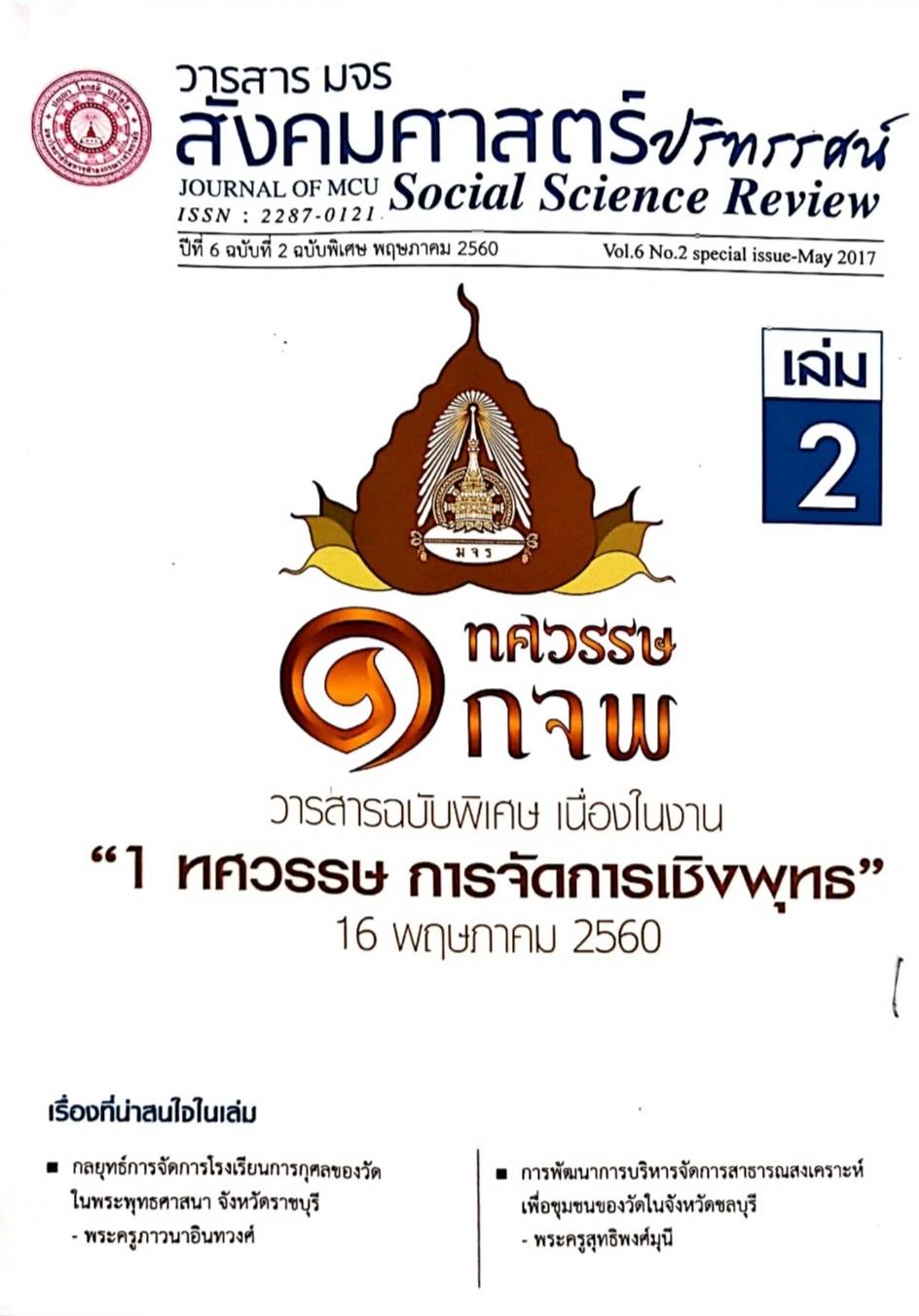ศึกษาวิเคราะห์วิธีกวนข้าวทิพย์ของพุทธศาสนิกชนในสังคมไทย
คำสำคัญ:
วิธีกวนข้าวทิพย์, พุทธศาสนิกชน, สังคมไทย.บทคัดย่อ
บทความวิจัยนี้มีวัตถุประสงค์ 3 ข้อ คือ 1) เพื่อศึกษาพิธีกรรมการกวนข้าวทิพย์ในพระพุทธศาสนา 2) เพื่อศึกษารูปแบบพิธีกรรมการกวนข้าวทิพย์ในสังคมไทย 3) เพื่อวิเคราะห์รูปแบบการกวนข้าวทิพย์ของพุทธศาสนิกชน ในสังคมไทยที่บูรณาการด้วยการกวนข้าวทิพย์ตามหลักพระพุทธศาสนาจากการศึกษา พบว่า การกวนข้าวทิพย์มีร่องรอยปรากฏอยู่ในพระไตรปิฎกเป็นอาหารที่ไม่มีเนื้อสัตว์เจือปนมีกรรมวิธีการในการหุง มีส่วนผสมมีน้านมเป็นหลักเป็นอาหารที่นิยมรับประทานกันในสมัยพุทธกาลพระพุทธเจ้าได้เสวยอาหารที่เรียกว่าข้าวมธุปายาส หรือข้าวทิพย์ที่สมัยปัจจุบันท้าให้พระองค์ได้ตรัสรู้ ดังนั้นสมัยปัจจุบันนี้เมื่อจะท้าพิธีกวนข้าวทิพย์จึงต้องอ้างอิงเรื่องนางสุชาดาเป็นเจ้าตำหรับคนแรกที่ได้น้าข้าวทิพย์ไปถวายพระมหาบุรุษ มีหลักฐานปรากฏชัดในสมัยรัชกาลที่ 5
ที่ทรงให้มีพระราชพิธีกวนข้าวทิพย์ในพระราชวัง โดยมีพระน้องนางเธอ พระเจ้าลูกเธอเป็นสาวพรหมจารีในการกวนประเพณีกวนข้าวทิพย์จะสำเร็จได้ต้องอาศัยความศรัทธาความเชื่อที่ยังมีอยู่ของประชาชนทั่วไป และผู้น้าในชุมชนที่จะร่วมมือกันอนุรักษ์ประเพณีนี้ไว้ เพราะต้องใช้ความร่วมมือร่วมใจของประชาชนจ้านวนมาก ในการเตรียมการ การจัดหาอุปกรณ์ในการกวน แรงงานในการกวน และการเตรียมการ โดยเฉพาะอย่างยิ่งเงินที่ใช้ในการจัดซื้อจัดหาสิ่งของต่าง ๆ เป็นจ้านวนมาก ด้วยเหตุผลข้างต้นในปัจจุบันบางวัด บางท้องที่จึงเลิกประเพณีกวนข้าวทิพย์นี้ไป เพราะขาดความพร้อมในเรื่องต่างๆ จากคติศรัทธาความเชื่อของชาวพุทธในประเทศไทยได้ขนานนาม“ข้าวมธุปายาส” ว่าเป็น“ข้าวกระยาทิพย์” หรือ “ข้าวทิพย์” สังคมคือกลุ่มคนที่อาศัยอยู่ด้วยกันในบริเวณใดบริเวณหนึ่ง มีความรู้สึกผูกพันร่วมมือกันในการถ่ายทอด ประเพณี วัฒนธรรม ความคิด และความเชื่อในสังคมในงานวันวิสาขบูชา ณมณฑลพิธีท้องสนามหลวงเป็นประจ้าทุกปี แต่ละภาคส่วน มีส่วนร่วมในการจัดเตรียมงานพิธี และประชาสัมพันธ์ เผยแพร่ความรู้ให้แก่สาธารณะชน พร้อมทั้งประสานงานกับหน่วยงาน ประชาชน กลุ่มองค์กรต่างๆ เป็นการสร้างเครือข่ายความช่วยเหลือซึ่งกันและกัน เพื่อให้บรรลุนโยบายของรัฐ เป็นการสนับสนุน สืบสานงานพิธีการกวนข้าวทิพย์ ในวันวิสาขบูชา ณ มณฑลพิธีท้องสนามหลวง
เอกสารอ้างอิง
เจ้าฟ้าธรรมธิเบศร ไชยเชษฐสุริยวงศ์. (2513). พระประวัติและพระนิพนธ์บทร้อยกรอง. ธนบุรี:โรงพิมพ์รุ่งวัฒนา.
นายแจ่ม ดีประวัติเปรียญ. (2500). ตารากวนข้าวทิพย์. กรุงเทพฯ:: โรงพิมพ์รุ่งเรืองธรรม.
ปิยะวัน เพชรหมี. (2556). การพัฒนาขนมกระยาสารทสินค้าของฝากของกลุ่มวิสาหกิจชุมชนนางิ้วอำเภอเมือง จังหวัดเพชรบูรณ์เพื่อรองรับเข้าสู่ประชาคมอาเซียน. บัณฑิตวิทยาลัย:มหาวิทยาลัยราชภัฎเพชรบูรณ์.
พระพรหมคุณาภรณ์ (ปอ.ปยุตฺโต). (2551). พิธีกรรมใครว่าไม่สำคัญ. กรุงเทพฯ:: บริษัทพิมพ์สวย จำกัด.
พระธรรมธีรราชมหามุนี (โชดก ญาณสิทฺธิ ป.ธ.9). (2533). ทาง 7 สาย. พิมพ์ครั้งที่ 7. กรุงเทพฯ::ห้างหุ้นส่วนจำกัดการพิมพ์
พระพรหมคุณาภรณ์ (ประยุทธ์ ปยุตฺโต). (2554). พิธีกรรมข้าวทิพย์ในเถรวาท. กรุงเทพฯ::พิมพ์สวย จำกัด
พุทธทาสภิกขุ. (2549). คู่มือดับทุกข์ฉบับสมบูรณ์. กรุงเทพฯ: สำนักพิมพ์ธรรมสภา.
มหาจุฬาลงกรณราชวิทยาลัย. (2539). พระไตรปิฎกภาษาไทย ฉบับมหาจุฬาลงกรณราชวิทยาลัย.กรุงเทพมหานคร: โรงพิมพ์มหาจุฬาลงกรณราชวิทยาลัย
สมเด็จพระปรมานุชิตชิโนรส. (2536). พระปฐมสมโพธิกถา. กรุงเทพฯ: เลี่ยงเชียงจงเจริญ.
สุมาลัย กาลวิบูลย์. (2528). การศึกษาเปรียบเทียบประเพณีสารท เดือนสิบกับแนวคิดเรื่องกรรมและการอุทิศส่วนกุศลในพุทธศาสนานิกายเถรวาท. วิทยานิพนธ์ศิลปศาสตรดุษฏีบัณฑิต. บัณฑิตวิทยาลัย: มหาวิทยาลัยศิลปากร.
ส. ธรรมภักดี. (2511). ประเพณีไทย ฉบับพระราชมหาราชครู. กรุงเทพฯ:: โรงพิมพ์ลูก ส.ธรรมภักดี.
อุรดินทร์ วิริยะบูรณะ. (2506).ประเพณีไทยฉบับพระมหาราชครู. กรุงเทพฯ: ประจักษ์การพิมพ์.
ดาวน์โหลด
เผยแพร่แล้ว
รูปแบบการอ้างอิง
ฉบับ
ประเภทบทความ
สัญญาอนุญาต
ลิขสิทธิ์ (c) 2020 วารสาร มจร สังคมศาสตร์ปริทรรศน์

อนุญาตภายใต้เงื่อนไข Creative Commons Attribution-NonCommercial-NoDerivatives 4.0 International License.
เพื่อให้เป็นไปตามกฎหมายลิขสิทธิ์ ผู้นิพนธ์ทุกท่านต้องลงลายมือชื่อในแบบฟอร์มใบมอบลิขสิทธิ์บทความให้แก่วารสารฯ พร้อมกับบทความต้นฉบับที่ได้แก้ไขครั้งสุดท้าย นอกจากนี้ ผู้นิพนธ์ทุกท่านต้องยืนยันว่าบทความต้นฉบับที่ส่งมาตีพิมพ์นั้น ได้ส่งมาตีพิมพ์เฉพาะในวารสาร มจร สังคมศาสตร์ปริทรรศน์ เพียงแห่งเดียวเท่านั้น หากมีการใช้ภาพหรือตารางหรือเนื้อหาอื่นๆ ของผู้นิพนธ์อื่นที่ปรากฏในสิ่งตีพิมพ์อื่นมาแล้ว ผู้นิพนธ์ต้องขออนุญาตเจ้าของลิขสิทธิ์ก่อน พร้อมทั้งแสดงหนังสือที่ได้รับการยินยอมต่อบรรณาธิการ ก่อนที่บทความจะได้รับการตีพิมพ์ หากไม่เป็นไปตามข้อกำหนดเบื้องต้น ทางวารสารจะถอดบทความของท่านออกโดยไม่มีข้อยกเว้นใดๆ ทั้งสิ้น





